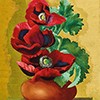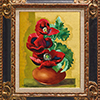PROVENANCE:
Collection of Hiroko Saeki, Inc., New York
Private collection, Paris
Private collection, Asia
ILLUSTRATED:
Kisling 1891-1953 Tome III , Edition Jean Kisling, text by Jean Dutourd, 1995, black and white illustrated, p. 281, no. 252
Catalogue Note:
ÉCOLE DE PARIS
Sanyu, an artist from early China who had lived in France, had stayed in Montparnasse of Paris for over forty years. His choice of themes such as female nudes, flowers and plants, figures and still lifes, were all closely associated with L'Ecole de Paris. This was especially apparent in Sanyu's potted flower series, a collection of later works currently kept in the National Museum of History in Taipei. To a large extent, Sanyu was inspired by Kisling in his depiction of different assortments of flowers and plants that appear to be vying for attention. In 1910, at the tender age of 19 Kisling set foot in Paris, the capital of art, imbued with lofty ideals. After some time, Kisling returned to Montparnasse and settled there for the next 27 years. During that period. In 1917, Kisling was given the title King of the Montparnos by historians and correspondents of fine arts, for the reason that Kisling's art is enshrouded in an aura of oriental mysticism due to its resplendent colors and distinctively characteristics. Moise Kisling is a truly pivotal artist of L'Ecole de Paris.
The 1910s to 1930s saw Paris undergoing a period known as La Belle Epoque, a time that stressed upon leisurely endeavors and sensory pleasures. Fine dining, fashion and fine arts collecting became flourishing aspects of this culture. The tastes and preferences of the Bourgeois very much favored L'Ecole de Paris. Beneath the rich and bright colors in Kisling's figure paintings, flower and plants, still lifes and landscapes, there was always a faint, lingering mystique and melancholy. A sense of the exotic, evoked by his adoption of the Slavic style from Eastern Europe, made Kisling's paintings exceptionally enchanting and thus wellreceived by the masses. After setting up an art studio in1943, the passionate Kisling re-created the bustling art scene of Montparnasse in New York. Due to the outbreak of World War II in Europe, Kisling continued to stay and develop his art in America until the war ended. He did not return to Paris until 1946. After the war, Kisling held his personal exhibitions at the Galerie Genegaud (1945) of Paris, Galerie Jouvene (1943) and Galerie Puget (1950) of Marseille. Chateau Musee, Cagnes sur Mer (1953) was the last to hold a personal exhibition for Kisling before he passed away.
Over the course of his life, Kisling has executed many still life paintings on floral paintings, all kinds of flowers have been captured in his brushes. As of the record, there are nearly 20 golden mimosa flower paintings, but there were only few painted in the theme of poppy flowers. The “Les trois pavots” presented in this spring sale was painted in 1952, the last of few remained outstanding paintings executed in the year prior to the death of the artist. The flower is still blooming in red, setting against the vivid green leaves. Despite the later period of his works were not executed in Cubist styles such as his earlier works, the structure and the composition of colors are still presented in three-dimensions, with flowers growing with vitality. In the same year of 1952, Kisling also painted a portrait of a woman, “Josane ” In that painting, the use of color tone is somewhat a resemblance of Les trois pavots.” The woman’s hair has dark yet shimmering blue, portrayed with melancholy eyes and looked downward; her head tilted slightly to a side. The resemblance of the portrait and the still life seemed to echo with one another. Both are painted with dense emotions and filled with dignity and pride in oneself. Was he really painting a flower or a portrait of a woman?
Up until now, the majority of the works of Moïse Kisling are in the collection of the Musée du Petit Palais in Geneva, other works are to be found in numerous museums including the Centre Pompidou, Paris, the Metropolitan Museum of Art and the Brooklyn Museum in New York.


